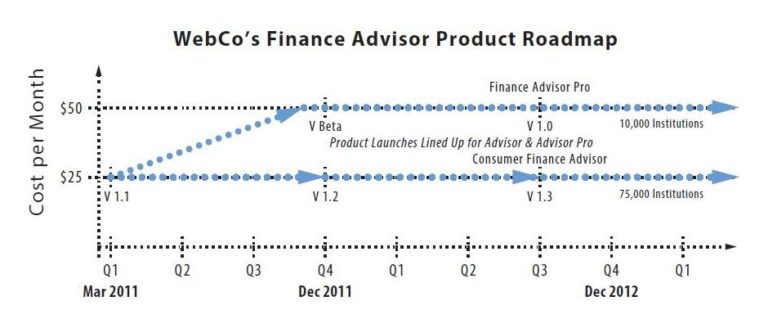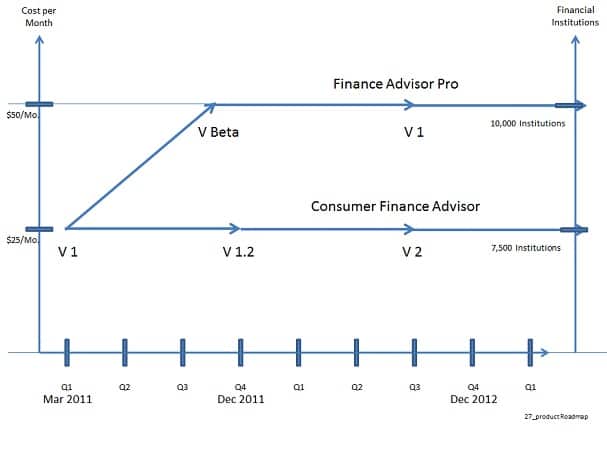H. Stanley Judd: “A good plan is like a road map: it shows the final destination and usually the best way to get there.“
What Is a Product Roadmap?
Product roadmaps often serve two masters and fail both. On one hand, the sales team uses them to close a sale because they insert the customer’s key wish into the product plan. On the other hand, product management uses them to assure the CEO that they plan to support their vision even though engineering has not looked at them. What they should do is to facilitate a company’s product development strategy.
This totally misses the point of the power of a well-executed product roadmap, which can be at its very best a visual explanation of a company’s strategy and therefore helps align engineering, marketing, sales, support, and the C-suite. Besides being a visual tool to communicate strategy, a product roadmap can inspire innovation because it signals the key areas that are the strongest differentiator. It can also inspire execution in that it helps to communicate platform and derivative strategies and how these unfold over time.
A product roadmap is a graphical representation of a set of related products over time (typically two product cycles or 24-36 months) with at most a monthly granularity (but often shown with quarterly resolution). The vertical axis is strategically the most important as it displays the products, how they relate to each other, and how they might relate to the competition in ways that matter. Although one of the most common vertical axes is cost, it can also be speed or the key-feature parameter.
Product Roadmap. What’s New?
Articulating a common vision for success is hardly a new concept, but it is rarely accomplished in a manner that ensures that all stakeholders and contributors truly understand the vision. A company can often generate a product plan from a variety of sources that have functionally focused views on what problems that company is trying to solve. However, these views are not always useful because they do not incorporate sufficient inputs to be reliable. A robust product roadmap is a cross-functionally created document that is reviewed by the CEO. It is not created to be communicated outside the company, but rather used to focus the company on the sequence of products developed over time.
This is a living document that serves as a repository for project ideas to be placed into the product development process. You should review and update it on a quarterly basis at a minimum.
What Are the Benefits of Product Roadmap?
- Provides a clear, visual representation of product strategy
- Inspires the organization to think about supporting innovations to drive parameters of importance
- Inspires the organization to see how they might get operational leverage by creating derivative products off of platforms
- Sets expectations for when the organization will deliver products/services to market
- Serves as an organizing principle for decisions around technology requirements, resource allocation, and product positioning
Which Business Problems Do We Solve with Product Roadmap?
Often individuals and managers in organizations say that there is no strategy, or if it exists, they say it is poorly communicated. An often-referenced product roadmap allows for better strategic alignment and as a result greater engagement. It also helps the executive management team and product marketing with managing the inputs to the new product development process. While a product roadmap should never preclude competitive reactions or innovation from “cutting in front of the line”, it does provide an active plan for what should be next on deck for development. The active use of a product roadmap helps innovation actively in at least two dimensions. The first is that it communicates through the vertical axis what is important to the organization. The second is that it provides a strategic context for engineers, researchers, and other creative individuals to come up with concepts that support, complement, and extend the strategic intent of the roadmap.
Finally, in the world of global product development, product roadmaps communicate the international launch strategy so that the organization plans the timing for entry into different markets and anticipates regulatory approvals, language, communication symbols, and standards.
What Are some Considerations?
In order to be most useful, the product roadmap must anticipate and lead changes in the market, in the channels, in the supply, and in the competitive landscape. So “shooting in front of the duck” is important because in most industries you have to anticipate what your competitors will have when you come out with your product 12 months from now. You should also be very careful not to focus too much on the competition. It is much more important to focus on supporting your vision and unique selling proposition than trying to guess every little move from your competitors. Often product roadmaps are useless because the focus is on some banal graphics of bubbles on an arrow. A product roadmap should be a scaled graph of at least two dimensions.
Product Roadmap Case Study
WebCo is experiencing great acceptance of their initial product launch and is now focused on multiple offerings of the product for a differentiated performance/value market. They are constructing a strategy to divide the product offering to compete between a high-performance/high-feature offering and an entry-level product. To ensure that the market does not consider them a “one-trick pony”, they want to construct a product roadmap to communicate their vision for the success of their offerings. They also aim to ensure that the teams and technology are in place to deliver a successful portfolio of products over the next five years.
They are branching from their roots as a direct-to-consumer company to add a high-margin product line that would be oriented toward financial planners. Their unique selling proposition (USP) is ease of use and simplicity of operation, which they need to have for both markets. Their other USP is connectedness with other financial institutions so that you can get your statements electronically and track your income and expenses. Their primary problem is how they can leverage as much of the core platform as possible and still provide additional features for the financial planners. The action is to go through a product planning and product road-mapping activity where they have looked at the USPs of the two products and clearly understood them to be selling price, user experience, and the number of financial institutions. This process is owned by Ray (the CMO), supported by Fred (the CTO), and approved by Rajiv (the CEO). In order to speed up the market analysis and the creation of the chart itself, Ray has borrowed Molly, a project manager who has really good research skills and can help with document creation.
The outcome is that the CEO has created and approved a product roadmap. One of the benefits is that they have clearly defined the USPs as the number of financial institutions they can exchange data with, the monthly subscription cost, and the simplicity of the user interface (maintained for the more complex product sold to financial planners and measured as the average time to do three tasks on the website). The second benefit is that everybody involved in supporting the roadmap has done resource planning at a high level. Finally, the company uses the roadmap in monthly all-hands meetings to communicate product updates to the entire company so that everyone feels more connected and relevant.
Download a template for Product Roadmaps.


